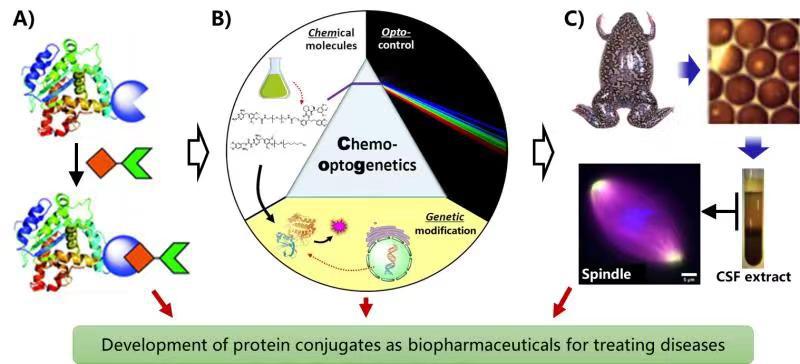Resume:
2004-2008: Sichuan University, B.Sc.
2008-2010: National University of Singapore, M.Sc.
2010-2012: Ulm University, Ph.D. (High Honors degree)
2012-2018: Max Planck Institute of Molecular Physiology & Chemical Genomics Centre of the Max Planck Society, Postdoc
2018-2019: Princeton University, Associate Research Scholar
2019-present: The HIT Center for Life Sciences, HIT, Principal Investigator
Research Interest:
The research in our group focuses on the development of chemical protein labeling (A), chemical genetic and chemo-optogenetic approaches (B) to facilitate the study of frontier biological questions related to cytoskeleton function (C). We will be particularly interested in understanding the mechanisms underneath metaphase spindle assembly for error-free chromosome segregation during cell division. The study will further guide us to rationally design protein-based therapeutics to treat diseases that are related to genomic instability, e.g., cancer.

Open Positions: We are seeking for 2 talented postdocs and 2-3 lab technicians. Candidates are expected to have one of the following research background: organic chemistry, protein bioconjugation chemistry, chemical biology, medicinal chemistry, biochemistry, molecular biology, immune cell therapy (e.g. CAR-T), phage display, directed evolution, gene editing, mice genetics, algorithm implementation (e.g. MATLAB, Python, etc.) or related fields, and should have a deep interest in conducting multi-disciplinary research crossing chemistry and life sciences. For application, please send a cover letter and a full CV to PI’s email address: chenxihit@hit.edu.cn. Candidates who passed the initial interview are expected to provide the contact information of two references and the two reference letters from them. This recruitment will continue until all positions are filled. |
Techniques and Tools in the Lab:
1.Multi-step organic synthesis (over 20 steps)
2.Site-selective chemical protein modification, bioconjugation chemistry, bioorthogonal chemistry
3.Peptide and protein synthesis, unnatural amino acid (UAA) incorporation
4.Molecular cloning (traditional cloning approaches, Gibson cloning, FastCloning, et al.)
5.Protein expression, purification and characterization
6.Molecular docking (MOE, PyMOL, et al.)
7.Cell culture (HeLa, HEK, Neuro-2a, COS-7, SH-SY5Y, MCF-7, PC-12, fibroblast cell lines, et al.) and organoid technology
8.Advanced imaging techniques (CLSM, TIRFM, EPI, multi-focal, AFM, two-photon, super-resolution, et al.) and image analysis (e.g. Fuji, et al)
9.Xenopus laevis frog (African clawed frog) egg extract cell-free system
10.Reconstitution of branching microtubule nucleation, spindle assembly, et al.
11.Chemo-optogenetics, optogenetics, and chemical genetics
Publications:
[1] X. Chen, M. Venkatachalapathy, L. Dehmelt, Y.-W. Wu*, Multidirectional activity control of cellular processes by a versatile chemo-optogenetic approach (Very Important Paper). Angew. Chem. Int. Ed.2018, 57, 11993-11997
[2]X. Chen, Y.-W. Wu*, Tunable and photoswitchable chemically induced dimerization for chemo-optogenetic control of protein and organelle positioning. Angew. Chem. Int. Ed.2018, 57, 6796-6799
[3] X. Chen#, M. Venkatachalapathy#, D. Kamps, S. Weigel, R. Kumar, M. Orlich, R. Garrecht, M. Hirtz, C. M. Niemeyer, Y.-W. Wu*, Leif Dehmelt*, “Molecular Activity Painting”: Switch-like, light-controlled perturbations inside living cells (Hot Paper/Cover Story; #: co-first author). Angew. Chem. Int. Ed.2017, 56, 5916-5920
[4] X. Chen, F. Li, Y.-W. Wu*, Chemical labeling of intracellular proteins via affinity conjugation and strain-promoted cycloadditions in live cells. Chem. Commun. 2015, 51, 16537-16540
[5]W. Liu#, F. Li#, X. Chen#, J. Hou#, L. Yi, Y.-W. Wu*, A rapid and fluorogenic TMP-AcBOPDIPY probe for covalent labeling of proteins in live cells (#: co-first author). J. Am Chem. Soc. 2014, 136, 4468-71
[6] X. Chen, F. Li, Y.-W. Wu, Affinity conjugation for rapid and covalent labeling of proteins in live cells (Chapter 15). Methods Mol. Biol.(“Proximity labeling: Methods and protocols”) 2019, Vol 2008, 191-202
[7] X. Chen, Y.-W. Wu, Selective chemical labeling of proteins. Org. Biomol. Chem. 2016, 14, 5417-5439
[8] X. Chen, L. Henschke, Q. Wu, B. Neumann, K. Muthoosamy, T. Weil, Site-selective azide incorporation into endogenous RNase A via a chemistry approach. Org. Biomol. Chem. 2013, 11, 353-61
[9] X. Chen, K. Muthoosamy, A. Pfisterer, B. Neumann, T. Weil, Site-selective lysine modification of native proteins and peptides via kinetically controlled labeling. Bioconjugate Chem. 2012, 23, 500-508
[10] X. Chen, Q. Wu, L. Henschke, G. Weber, T. Weil, An efficient and versatile approach for the preparation of a rhodamine B ester bioprobe library. Dyes Pigm. 2012, 94, 296-3038
[11] X. Chen, A. Pfisterer, K. Müllen, T. Weil, Site-directed protein and peptide chemistry via tailored bioorthogonal reagents. Abstr. Pap. Am. Chem. Soc. 2011, 241, 681-ORGN
Book Chapter(s):
[12] X. Chen, S. Voss, Y.-W. Wu, Chemoselective modification of proteins (Chapter 8)
Wiley-VCH (“Chemical ligation: Tools for biomolecule synthesis and modification”) 2017, 285-338.
European & PCT Patent(s):
[13] Y.-W. Wu, X. Chen, Photo-switchable chemical inducers of dimerization for control of protein functions in cells by light
as European Patent: Patent No. EP3424922A1, published on January 9th, 2019
as PCT Patent: Patent No. WO2019008175, published on January 10th, 2019